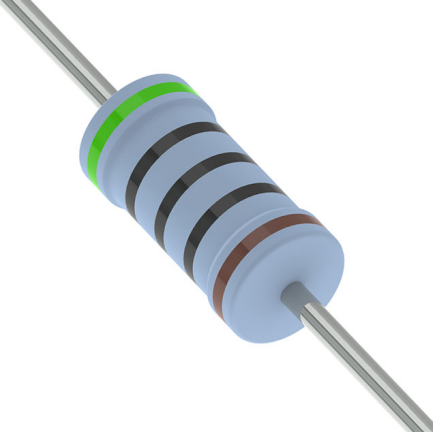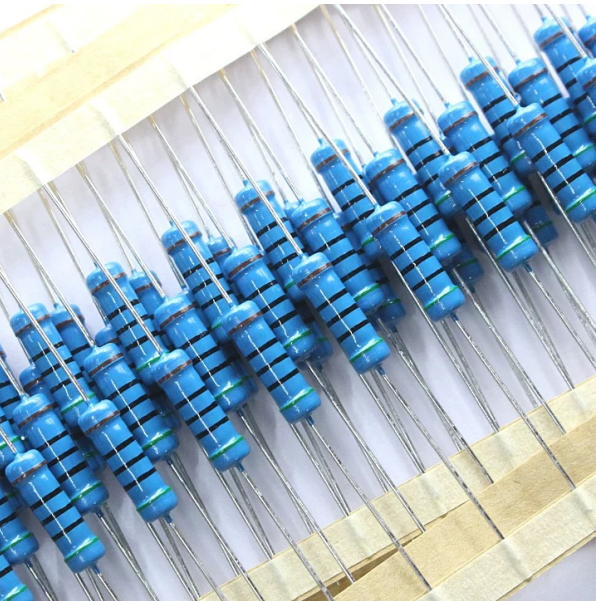A 500 ohm resistor is a type of electrical component use in electronic circuits to limit the flow of electric current. Can use it to protect sensitive components like LEDs, transistors, or integrated circuits from receiving too much current, which can damage them. Resistors are for controlling voltage, current, and ensuring the proper functioning of a circuit. The 500-ohm value is particularly useful in scenarios where need moderate resistance for power regulation. While a 500R resistors may seem like a specific value, its applicability in various circuits is quite broad because the versatility of resistors in different configurations.
1. What is a 500 Ohm Resistor?
2. Features of 500 Ohm Resistors
3. Packaging Types for 500 Ohm Resistors
4. Resistor 500 Ohm Color Code
5. Comparing 500 Ohm Variable Resistor vs Fixed Resistor
6. 500 Ohms Resistor Application
7. Rating Wattage in 500 Ohm Resistors
8. When Working with Resistors 500 Ohm
9. Frequently Asked Questions [FAQ]

1. What is a 500 Ohm Resistor?
A 500-ohms resistors is a fixed-value circuits that provides a resistance of 500Ω, which is the amount of opposition it provides to the current. This means it resists the flow of electrical current by 500 ohms, which is determined by the material, shape, and size of the resistor. The resistance value measure in ohms(Ω) and use to control current and voltage in a circuit.
This value design to perform specific tasks in a circuit. For example, a 500-ohm resistor may use to reduce the current flowing to an LED so that it doesn't burn out.
500 ohms use in a variety of applications in electronic circuits, particularly in scenarios where current limiting is necessary. The value of resistance makes them suitable for small to moderate power applications.
2. Features of 500 Ohm Resistors
500Ω is a fixed-value passive component use in countless electronic applications, from basic LED circuits to advanced signal processing and industrial control systems. Its well-balanced resistance, reliable performance, and wide availability make it one of the most versatile resistor types on the market. Below are the key features that determine their suitability for different applications.
Precise Resistance
Its accurate and stable resistance value, design to maintain a fixed resistance of 500 ohms, ideal for controlling current and managing voltage levels in circuits. This makes it useful in applications like voltage dividers, current limiting, biasing, and filtering, where requiring precise control of electrical current.
Available in Multiple Tolerances
Offer in a wide range of tolerance values, allowing engineers to choose the right component based on precision requirements. Common tolerance ratings include:
|
Tolerance (%) |
Range (Ohms) Ω |
Description |
|
±0.002% |
499.99~500.01 |
High precision
|
|
±0.0025% |
499.9875~500.0125 |
|
|
±0.005% |
499.975~500.025 |
|
|
±0.01% |
499.95~500.05 |
|
|
±0.02% |
499.9~500.1 |
Precision
|
|
±0.05% |
499.75~500.25 |
|
|
±0.1% |
499.5~500.5 |
Tight tolerance |
|
±0.25% |
498.75~501.25 |
|
|
±0.5% |
497.5~502.5 |
Standard precision |
|
±1% |
495~505 |
|
|
±2% |
490~510 |
General purpose |
|
±5% |
475~525 |
Common tolerance (4-band) |
|
±10% |
450~550 |
Loose tolerance, legacy use |
Lower tolerance resistors are ideal for applications that demand tight control of resistance, such as instrumentation and medical devices.
Offered in Various Package Types
To support different circuit layouts and assembly methods, 500R-resistors come in several package styles, including:
· Axial lead for through-hole PCBs
· Radial lead for compact vertical mounting
· Surface Mount Device (SMD) resistors in popular sizes like 0201, 0402, 0603, 0805, 1206 , 1810, 2010 and 2512
SMD 500Ω resistors are the preferred choice for compact, high-density electronics such as mobile devices, wearables, and IoT systems.
Different Power Ratings for Thermal Management
With various power dissipation to suit different current and voltage demands. Common wattage include: 1/8 watt (0.125W),1/4 watt (0.25W),1/2 watt (0.5W),1 watt and higher.
Choosing the correct wattage ensures the circuit can handle the power without overheating or degrading, which is necessary for circuit safety and longevity.
Low Temperature Coefficient for Stability
With a low temperature coefficient, which means their resistance value changes very little with temperature fluctuations. This makes them ideal for environments where require thermal stability , such as automotive electronics, aerospace systems, and high-precision analog circuits.
Constructed from a Variety of Materials
Depending on the required performance characteristics, 500 ohms are available in several material types:
· Carbon Film Resistors: Cost-effective, general-purpose
· Metal Film Resistors: High precision, low noise, low temperature coefficient
· Wire-Wound Resistors: High power handling, excellent stability
· Thick Film and Thin Film Resistors: Common in SMD designs, with good balance between size and accuracy
Each type has unique advantages suited for different electronic designs and environmental conditions.
RoHS Compliance and Environmental Safety
RoHS-compliant, meaning they are free of hazardous substances like lead and mercury. Also manufacture to meet global environmental and safety standards, ensuring they are safe for use in consumer electronics, medical equipment, and industrial machinery.
Broad Availability and Application Flexibility
To their popularity and utility, 500-ohms are readily available from all major electronics distributors. They use in an enormous range of applications, including:
LED current limiting, Audio filters and tone control, Operational amplifier feedback networks, Analog signal conditioning, Embedded systems and microcontroller circuits.
Their flexibility in both low-voltage and moderate-power scenarios makes them a go-to component for engineers, educators, and electronics enthusiasts.
3. Packaging Types for 500 Ohm Resistors
Based on the application and how the component is to mount onto the PCB (Printed Circuit Board). Here are the most common types:
Through-Hole Resistors: Have leads (wires) that pass through holes on a printed circuit board (PCB). These leads solder on the opposite side to provide strong mechanical bonds and reliable electrical connections. Common in breadboards, development boards, and traditional PCB assemblies.
Axial Resistors: Cylindrical with two leads extending from each end. These are typically use in through-hole mounting applications. Common use in general-purpose circuits, audio equipment, and power supplies.
Axial-4 Leads: Specialized axial resistors with four leads, use for applications requiring more robust connections.
Radial Resistors: Have leads extending from one end, allowing them to be mounted on PCBs in a compact and space-efficient manner. Can save PCB space compared to axial in some layouts.
Radial-4 Leads: Similar to axial-4 leads, these have four leads and use for more durable applications.
Surface Mount (SMD) Resistors: Ideal for automated assembly processes. Some popular SMD sizes include:
0201, 0202, 0402, 0603, 0805, 1206, 1210, 1812, 2010, 2512
These sizes represent the dimensions of the resistor package in inches (width x length), with smaller packages use for high-density circuits. The preferred choice for compact, high-density electronics such as mobile devices, wearables, and IoT systems.
TO-220 Resistors:
· Typically use for higher power dissipation, often in power supply applications.
Types of 500 Ohm Resistors
Come in various types depending on their construction and application. When selecting a 500R-resistor for your circuit, understanding the different packaging types helps ensure the resistor fits properly and performs well in your application. Some common ones for a 500-ohm-resistor include:
· Carbon Film Resistors: The most common type, providing a cost-effective option for general-purpose circuits. They have a moderate tolerance and are usually use in low to medium-power applications.
· Metal Film Resistors: Provide higher accuracy and lower tolerance than carbon-film-resistors. Ideal for precision circuits where require accuracy.
· Wire-Wound Resistors: Used when need high power ratings. Can handle larger amounts of power dissipation without overheating.
· Surface Mount Resistors (SMD): The small size use in compact circuits, commonly in modern electronic devices like smartphones and computers.
4. Resistor 500 Ohm Color Code
Resistors use a color-coding system to denote their resistance value. The color codes are in 3 types: 4-band ,5-band and 6-band:
|
Color |
Digit |
Multiplier |
Tolerance |
|
Black |
0 |
1Ω |
– |
|
Brown |
1 |
10Ω |
±1% |
|
Red |
2 |
100Ω |
±2% (G) |
|
Orange |
3 |
1KΩ |
– |
|
Yellow |
4 |
10KΩ |
– |
|
Green |
5 |
100KΩ |
±0.5% |
|
Blue |
6 |
1MΩ |
±0.25% |
|
Violet |
7 |
10MΩ |
±0.1% |
|
Grey |
8 |
- |
±0.05% |
|
White |
9 |
0.001Ω |
– |
|
Silver |
– |
0.01Ω |
±10% |
|
Gold |
– |
0.1Ω |
±5% (J) |
4-Band Color Code:
|
Band Number |
Function |
Color |
Value |
|
1 |
1st-Digit |
Green |
5 |
|
2 |
2nd-Digit |
Black |
0 |
|
3 |
Multiplier |
Brown |
×10 |
|
4 |
Tolerance |
Gold |
±5% |
Calculating the Resistance
Combine 1st and 2nd digits: 5 and 0 → 50
Multiply by the multiplier: 50 × 10 = 500 Ω
Tolerance: ±5%
Green represents the first digit (5), Black represents the second digit (0), Brown represents the multiplier (×10), and Gold represents the tolerance (±5%). So 4-band coding= Green - Black - Brown - Gold .

5-Band Color Code:
|
Band Number |
Function |
Colour |
Value |
|
1 |
1st-Digit |
Green |
5 |
|
2 |
2nd-Digit |
Black |
0 |
|
3 |
3rd-Digit |
Black |
0 |
|
4 |
Multiplier |
Black |
×1 |
|
5 |
Tolerance |
Brown |
±1% |
Calculating the Resistance
· Combine the first three digits: 5, 0, and 0 → 500
· Multiply by the multiplier: 500 × 1 = 500 Ω
· Tolerance: ±1%
A 5-band resistor with the colour coding Green - Black - Black - Black - Brown represents a 500 Ω ±1% resistor.
6-band color code:
|
Band Number |
Colour |
Value |
|
1st-Band |
Green |
5 |
|
2nd-Band |
Black |
0 |
|
3rd-Band |
Black |
0 |
|
4th-Band |
Black |
Multiplier (×1) |
|
5th-Band |
Brown |
Tolerance (±1%) |
|
6th-Band |
Red |
Temp. Coefficient (100 ppm/°C) |
Result:
Resistance Value: 500 Ohms (5, 0, 0 × 1 = 500)
Tolerance: ±1%
Temperature Coefficient: 100 ppm/°C
6-band resistor provides more precision with its temperature coefficient feature, which indicates how much the resistor's value changes with temperature.
Resistor Color Code Comparison (4-Band, 5-Band, 6-Band)
|
Band Position |
4-Band |
5-Band |
6-Band |
|
1st-Band |
1st-digit Green(5) |
1st-digit Green(5) |
1st-digit Green(5) |
|
2nd-Band |
2nd-digit Black(0) |
2nd-digit Black(0) |
2nd-digit Black(0) |
|
3rd-Band |
Multiplier Brown(×10) |
3rd-digit Black(0) |
3rd-digit Black(0) |
|
4th-Band |
Tolerance Gold(±5%) |
Multiplier Black (×1) |
Multiplier Black (×1) |
|
5th-Band |
N/A |
Tolerance Brown(±1%) |
Tolerance Brown(±1%) |
|
6th-Band |
N/A |
N/A |
Temperature Coefficient Red(100 ppm/°C) |
Key Differences:
4-Band-Resistors: Simple, use for standard applications. 3 bands for value (2 digits + multiplier) and 1 for tolerance.
5-Band-Resistors: More precise, use for tighter tolerances. 3 digits for value, 1 multiplier, and 1 tolerance band.
6-Band-Resistors: High precision with temperature coefficient, use for highly sensitive or precision circuits. Same as 5-band but adds temperature coefficient (indicating how much the resistance changes with temperature).
Temperature Coefficient Table for Resistor Colour Codes
|
Band Color |
Temperature Coefficient (ppm/°C) |
|
Black |
0 |
|
Brown |
100 |
|
Red |
50 |
|
Orange |
15 |
|
Yellow |
25 |
|
Green |
20 |
|
Blue |
10 |
|
Violet |
5 |
|
Gray |
1 |
|
White |
0 |
Explanation:
The temperature coefficient indicates how much the resistor’s value will change for every 1°C change in temperature. A higher ppm value means the resistance will change more with temperature. Brown (100 ppm/°C) means the resistor will change by 100 ohms per million ohms for every degree change in temperature.
5. Comparing 500 Ohm Variable Resistor vs Fixed Resistor
A 500 ohm fixed resistor has a fixed resistance value and cannot adjust. Commonly use for setting a precise resistance value in a circuit.
On the other hand, a 500-ohms variable resistor (or called a potentiometer) allows for adjusting the resistance manually. This makes it ideal for applications where the resistance needs to be tuned or varied, such as volume controls or dimmers.
|
Feature |
500-Ohm Variable Resistor |
500-Ohm Fixed Resistor |
|
Definition |
Resistance value can adjust manually or electronically within a range that includes 500Ω |
With a fixed resistance value of exactly 500 Ω |
|
Resistance Value |
Adjustable (e.g., from 0 Ω up to several kΩ including 500 Ω) |
Fixed at 500 Ω with a specified tolerance (e.g., ±1%, ±5%) |
|
Structure |
Typically potentiometer, rheostat, or trimmer with a movable contact (wiper) |
A single piece of resistive material with fixed value |
|
Function |
Allows tuning or calibration of resistance in a circuit |
Provides a stable, unchanging resistance |
|
Applications |
Volume controls, tuning circuits, adjustable voltage dividers, calibration |
Current limiting, voltage dropping, pull-up/down resistors, signal conditioning |
|
Size/Form Factor |
Usually larger or bulkier due to moving parts |
Can be small, especially surface-mount fixed resistors |
|
Accuracy & Stability |
Less precise because mechanical wear, contact noise, and adjustment variability |
More precise and stable over time and temperature |
|
Power Rating |
Lower power ratings |
Available in wide range of power ratings. |
|
Cost |
Generally more expensive. |
Usually lower cost and widely available |
|
Adjustability |
Can adjust multiple times during operation |
Cannot adjust; fixed once manufacture. |
|
Common Types |
Potentiometers, trimmer resistors, digital potentiometers |
Carbon film, metal film, wirewound, SMD resistors |
|
Typical Use Case |
Fine-tuning circuit behavior after assembly or during operation |
Providing consistent, predictable resistance values in circuits |
Summary
|
Aspect |
Variable Resistor |
Fixed Resistor |
|
Use Case |
When resistance needs to adjust/tuned |
When resistance must stay constant |
|
Precision |
Lower, subject to adjustment errors |
Higher, stable and reliable |
|
Physical Size |
Larger, has moving parts |
Compact, solid |
|
Durability |
Mechanical wear possible |
Long-lasting |
|
Cost |
More costly |
Cost-effective |
Key Differences:
· Adjustability: Fixed resistors are non-adjustable, while variable-resistor can be fine-tuned.
· Use Case: Fixed resistors use where need consistent resistance, while variable-resistors use in applications requiring adjustable resistance.
· Design: Variable type typically have a knob or screw to adjust the resistance, while fixed-resistors are compact with no adjustable parts.
6. 500 Ohms Resistor Application
500 ohm resistors widely use in many applications, particularly where need moderate resistance values for controlling current or voltage levels. Common include:
· Current Limiting: To limit the current flowing through specific parts of a circuit, such as LEDs, transistors, and integrated circuits.
· Voltage Division: In voltage divider circuits to obtain a specific output voltage.
· Filter Circuits: Use in RC (Resistor-Capacitor) or RL (Resistor-Inductor) filters for frequency response adjustments.
· Pull-up and Pull-down Resistors: Use in digital circuits to set default logic levels when no apply active signal.
7. Rating Wattage in 500 Ohm Resistors
Indicates how much power it can safely dissipate without damaged. For 500-ohm resistors, common include:
|
0.05W(1/20W) |
1W |
5W |
|
0.1W(1/10W) |
1.5W |
6W |
|
0.125W(1/8W) |
1.75W |
6.5W |
|
0.2W(1/5W) |
2W |
7W |
|
0.25W(1/4W) |
2.25W |
8W |
|
0.3W |
2.5W |
10W |
|
0.5W(1/2W) |
3W |
11W |
|
0.6W |
3.25W |
13W |
|
0.667W(2/3W) |
3.75W |
15W |
|
0.75W(3/4W) |
4W |
20W |
· 500 Ohm 1 Watt Resistor: Suitable for moderate power applications, like low-power circuits or general-purpose uses.
· 500 Ohm 1/2 Watt Resistor: Common in smaller, low-power electronic devices and circuits.
· 500 Ohm 1/4 Watt Resistor: Use in circuits where low power dissipation is required, such as signal processing or high-density board designs.
· 500 Ohm 2 Watt Resistor: Ideal for higher-power applications, where a higher voltage or current needs to dissipate safely.
· 500 Ohm 5 Watt Resistor: Suitable for high-power circuits, such as power supplies or large audio systems.
Choosing the appropriate wattage rating ensures the resistor can handle the power dissipated without overheating or failing.
8. When Working with Resistors 500 Ohm
Several considerations must be kept in mind:
· Power Dissipation: Ensure that the resistor’s power rating is suitable for the current passing through it to avoid overheating.
· Tolerance: Depending on the precision required in your circuit, choose a resistor with the appropriate tolerance.
· Temperature Coefficient: If the resistor will subject to varying temperatures, choose a resistor with a low temperature coefficient to maintain its performance.
· Mounting Type: Select the proper packaging (axial, radial, or surface mount) depending on the circuit design and manufacturing process.
1. Current Limiting in Circuits
Use to limit current to LEDs, transistors, or other components. For example, if you want to protect an LED from drawing too much current, can choose a 500Ω based on the supply voltage and desired LED current.
2. Voltage Division
When you need a voltage divider that outputs a specific voltage less than the input, 500Ω can be part of the resistor pair. Choosing to helps balance power consumption and size.
3. Signal Conditioning
In analog circuits, use 500Ω to condition signals—for example, reducing signal amplitude or shaping filter response.
4. Pull-up / Pull-down Resistors
Serve as a pull-up or pull-down resistor in digital circuits to ensure a known logic level when switches or inputs are open.
5. Feedback Networks in Amplifiers
In operational amplifier circuits, use in the feedback loop to set gain or bandwidth characteristics.
6. Impedance Matching
Can help with impedance matching between different stages of an electronic system, improving signal integrity.
500 Ohm Resistor Price
Depends on several factors:
Packaging Type: SMD resistors typically cost more than through-hole resistors.
Power Rating and Tolerance: Precision resistors (with low tolerance) or high-wattage resistors are typically more expensive.
Manufacturer and Quality: Resistors from well-known manufacturers may cost more due to better quality control and reliability.
Typically, the price for standard 500 ohm resistors ranges from 0.0005 to a few dollars, depending on the factors mentioned.
9. Frequently Asked Questions (FAQ)
1.What color is a 500 ohm resistor?
Available in 3 types bands colour coding :
4-Band: Green - Black - Brown - Gold (500Ω, ±5% tolerance)
5-Band: Green - Black - Black - Black - Brown (500Ω, ±1% tolerance)
6-Band: Green - Black - Black - Black - Brown - Red (500Ω, ±1% tolerance, 100 ppm/°C)
2.What is 500 ohms mean?
500 ohms is a measure of electrical resistance. 500Ω resistors will resist the flow of current in a circuit.
3.What resistor to use with LED?
The choice of resistor for an LED depends on the LED’s forward voltage and the desired current. For typical LEDs, a resistance value ranging from 330 ohms to 1k ohm is common.
4.What is a 500 ohm resistor used for?
A 500-ohms-resistor use to:
Limit current in components like LEDs.
Divide voltage in circuits.
Condition signals in analog circuits.
Stabilize logic levels in digital circuits (pull-up/pull-down).
Set gain in amplifiers and op-amps.
For controlling electrical flow and ensuring component safety.
5.How to read resistor color code?
The colour coding on a resistor indicates its value and tolerance. Each color corresponds to a number (e.g., black = 0, green = 5). Learn the color code chart to decode resistors accurately.
For 4-band-resistor:
First two bands: These are digits (e.g., Green = 5, Black = 0 → 50).
Third-band: Multiplier (e.g., Brown = ×10 → 50 × 10 = 500).
Fourth-band: Tolerance (e.g., Gold = ±5%).
Example: Green - Black - Brown - Gold = 500 Ohms with ±5% tolerance.
6.How many ohms do you need for an LED?
The resistor needed for an LED depends on the LED’s voltage rating and the supply voltage.
To power an LED, you typically need a resistor to limit the current. The value of the resistor depends on:
· The supply voltage (e.g., 5V, 12V)
· The LED type (different LEDs have different voltage requirements)
· The desired current (usually around 20mA for standard LEDs)
For most 5V circuits and standard LEDs, a resistor between 150Ω and 330Ω commonly use.
If you're working with a specific LED, you can adjust the resistor value based on the LED’s forward voltage and current rating.
Read More:
1. 330 Ohm Resistor and Color Code











 Product Catalog
Product Catalog






